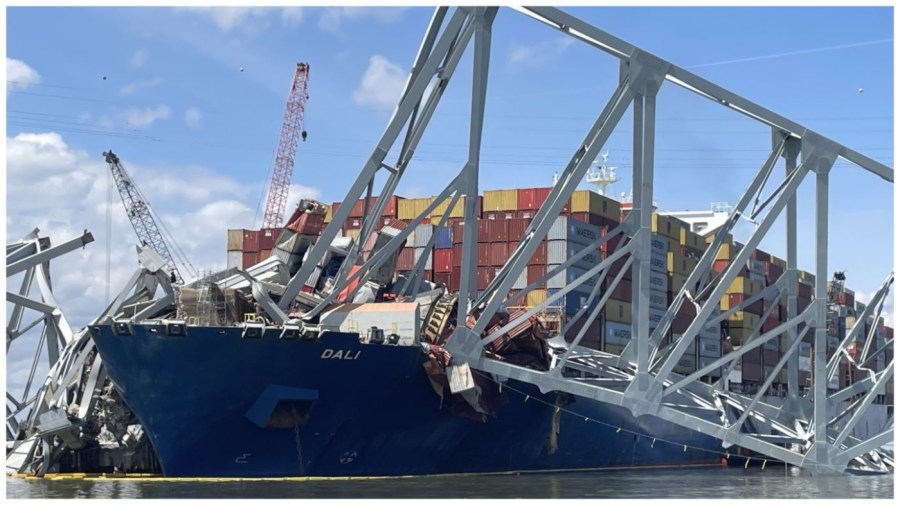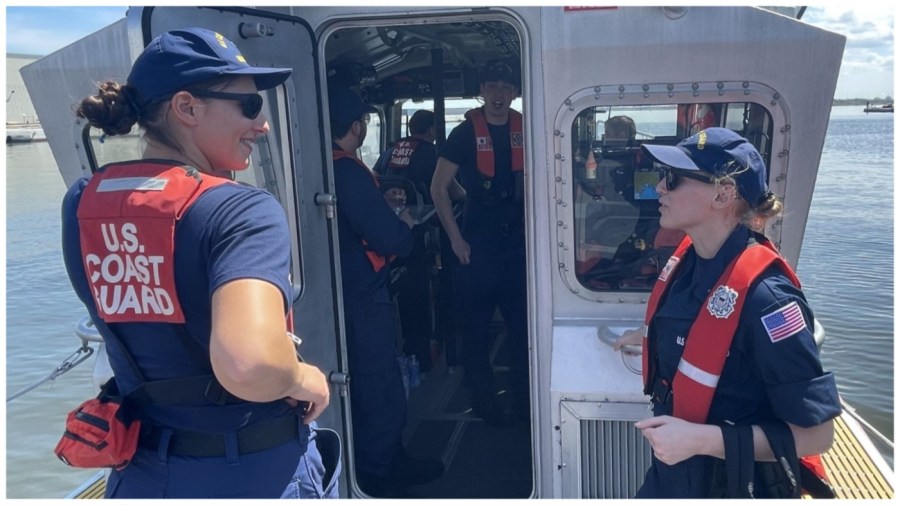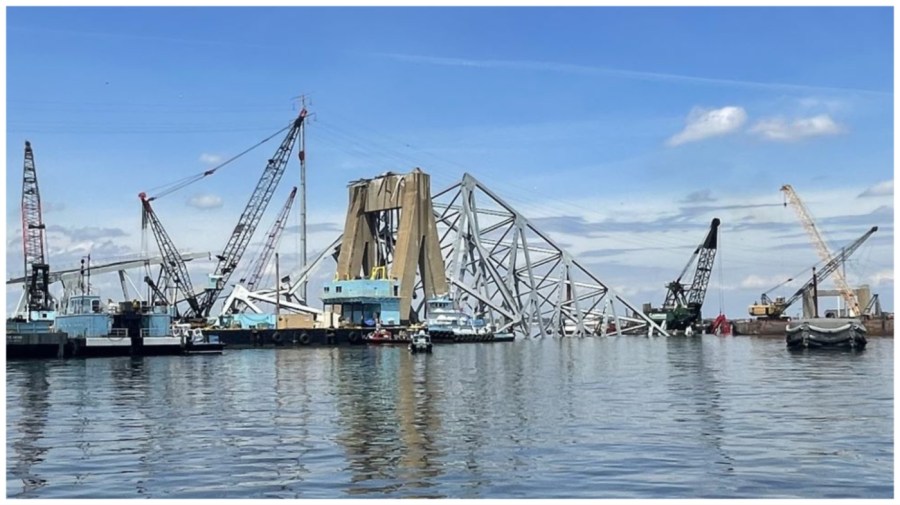Inside the military’s response to the Baltimore bridge collapse
Inside a Baltimore cruise terminal last week, dozens of military personnel were spread out across a wide room under bright lights, with workers bent over computers across rows of tables hastily arranged as workstations.
This is the bustling operations center for the Unified Command leading the response to the total collapse of the Francis Scott Key Bridge late last month.
Officials are working day and night to rid Baltimore of the bridge scraps and reopen the vital national port on a tight schedule: A tentative goal has been set to finish the debris removal and fully reopen the port by the end of May.
U.S. Coast Guard Cmdr. Roberto Concepcion, speaking to The Hill during a visit this month, said that was a “very aggressive” goal, but a necessary one.
“We got to establish aggressive goals … because a lot of jobs are on the line, there’s a lot of stakeholders,” he said. Still, he added, “there’s so many different factors and things that can happen.”
The March 26 bridge collapse has left massive heaps of steel and concrete debris floating in the water and has largely shut down one of the busiest ports in the country at an estimated loss of $15 million a day.
This incident command post, set up within one day from the bridge collapse, is a vast network of agencies and officials, working in unison to reopen the Baltimore port and eventually start rebuilding the bridge. The network has more than 370 personnel and 80 assets, like boats and cranes.
The Unified Command post is run by the Federal Emergency Management Agency, but includes the U.S. Coast Guard, U.S. Navy and the U.S. Army Corps of Engineers, Maryland Department of the Environment, Maryland Transportation Authority and Maryland State Police.
The cruise terminal is a scene of perpetual activity. In the far corner is a supply station to distribute crucial materials to crews. A catering table filled with snacks and other food lies just beyond the main room in a small hallway. Outside the warehouse-sized terminal in the parking lot is a long trailer acting as a mobile communications hub.

Salvage companies hired as government contractors are carrying out the brunt of the work to remove the debris, which is scattered in separate chunks of steel bridge in a line across the murky waters of the Baltimore port. There is estimated to be 50,000 tons of steel and concrete, with some parts extending all the way from the surface to deep underwater.
One of the largest pieces of scrap is hanging across the front of the 984-foot container ship called the Dali, chartered by shipping giant Maersk. The merchant vessel reportedly lost power in the early morning hours of March 26 before plowing into the Key bridge and forcing its total collapse. The FBI has reportedly opened a criminal probe into the crash.
Crews are also removing some containers from the Dali ship so they can eventually move the container vessel out of the debris field, a major priority in the mission.
Maryland Gov. Wes Moore (D) said in a Tuesday press conference that the operation underway to remove the debris is “remarkable,” describing the Dali as the “weight of the Washington Monument,” surrounded by “tens of thousands of tons of steel.”
“This type of and this kind of complexity is unprecedented,” Moore said. “And seeing the professionalism and the way that this team [is working] has been absolutely extraordinary.”
Contractors have deployed barges, construction ships and floating docks to facilitate access to the site, along with 500-ton and 1,000-ton cranes for lifting.
Much of the work requires intensive cutting of the fallen bridge parts to remove pieces of the debris one at a time, before transporting the scrap to a special site at nearby Sparrows Point for recycling or disposal. The cutting is a careful process because crews must make surgical cuts to safely remove pieces from a larger structure. Crews are using tools like torches, hydraulic shears and diamond wire saws.
The U.S. Navy is also involved with the response. The Navy’s Supervisor of Salvage and Diving is tasked with overseeing the commercial dive companies going underwater for cutting and search operations.
Navy Lt. Cmdr. Rob Carelli said the companies under contract are experienced but described the mission as challenging because there are a lot of “unknowns,” and progress depends on the weather cooperating.
“We had a few days that were pretty gloomy weather with high winds and a lot of rain,” he said. “It just kind of shifts what we do on those days.”
Though Carelli acknowledged the work was demanding, he said the mission is extremely important.
“We’ve all seen the economic impact and the impact to people’s lives,” he said. “So there’s a great motivation and fulfilling part of the job in helping to restore” the port.

Another key part of the bridge response is from the U.S. Army Corps of Engineers, which is under the Army but is primarily a civilian workforce. Around 62 engineers are employed in the bridge response, though roughly 1,100 are available if needed.
One way the Army Corps is helping is to provide information to protect divers, who have limited visibility in the murky waters and riverbed of the Patapsco River. These divers are tasked with reporting on the underwater wreckage.
Rick Benoit, emergency management specialist at the North Atlantic division of the Army Corps, called it an “unusual mission with an uber-extreme work environment of dark, cold water.”
“Beneath those waters, divers are moving as if playing an underwater game of Twister and Jenga with hundreds of tons of shattered concrete and twisted steel in complete darkness,” Benoit said in an Army Corps press report.
John Hill, a lead engineering technician with the Army Corps, said his job is to monitor data for the channels of the Baltimore port and relay that information to on-site crews.
He said a 65-foot survey boat takes images of the bottom of the river channel and sends the data back to him for processing, which signals where it’s safe for ships to cross.
Hill recalls being “stunned” when he first realized the extent of the bridge collapse.
Despite the unprecedented nature of the collapse, Cynthia Mitchell, media operations chief for the Baltimore district of the Army Corps, said the response has been fairly smooth, with the Unified Command employing lessons learned from other disasters.
“The muscle memory was there for us,” she said. “This was a matter of everybody coming together very quickly.”
Besides debris removal, the emergency responders are still searching for the remaining two bodies of the six construction workers who died when the Key bridge collapsed. A fourth body was found just this week. Workers must first remove the entangled debris to clear the way for search and recovery.
“A lot of hazards down there,” said Concepcion with the Coast Guard, “the water being so murky and you can only see so far. It’s super difficult because the last thing you want is some diver caught in the debris.”
The U.S. Coast Guard is also tasked with patrolling the waters of the port to ensure no ship crosses the 2,000-yard boundary line that is closed off while work is underway. Along with Coast Guard patrol boats, drones buzz around.
Coast Guard ships are a frequent sight around the port, with the small vessels also zooming across the waters to transport media and press to take videos and photos of the bridge.
There are two smaller access channels currently operational on either side of the debris field, Hawkins Point and Sollers Point, where empty barges, small tugs, survey vessels, crane barges and the Coast Guard can move through.
The goal in the coming weeks is to reopen the 50-foot deep and 700-foot wide federal channel that would allow for full access to the port of Baltimore.
President Biden visited the Baltimore port earlier this month, where he called the military personnel and responders the “finest engineers in the world” and announced the third channel of the port would be reopened by the end of April and the full port by the end of May.

Workers on the front lines of the effort are optimistic about meeting that goal.
“Everybody’s working together really well,” Coast Guard Petty Officer 1st Class Claudio Giugliano said. “Everybody has the same goals in mind.”
Coast Guard Rear Adm. Will Watson said the “nucleus” of the team was its committed staff.
“Without their dedicated effort, this team would not go, it would not work as smoothly and effectively as it has,” he said at the Tuesday press conference.
“We often refer to the Unified Command when we talk about the structured network of people and professionals doing this great work. But I think it’s good for us to remember at the heart of it all is people.”
Copyright 2023 Nexstar Media Inc. All rights reserved. This material may not be published, broadcast, rewritten, or redistributed.

